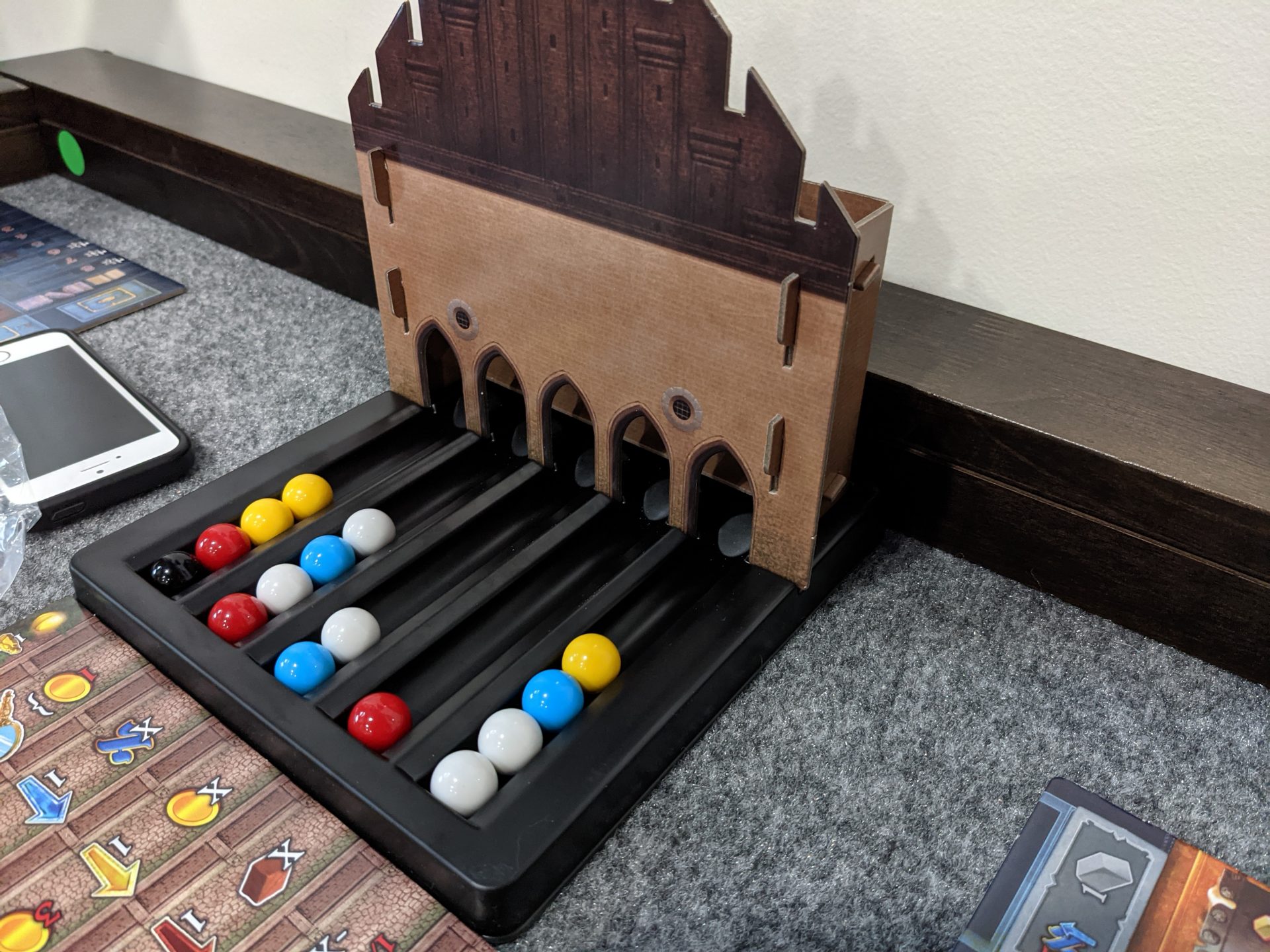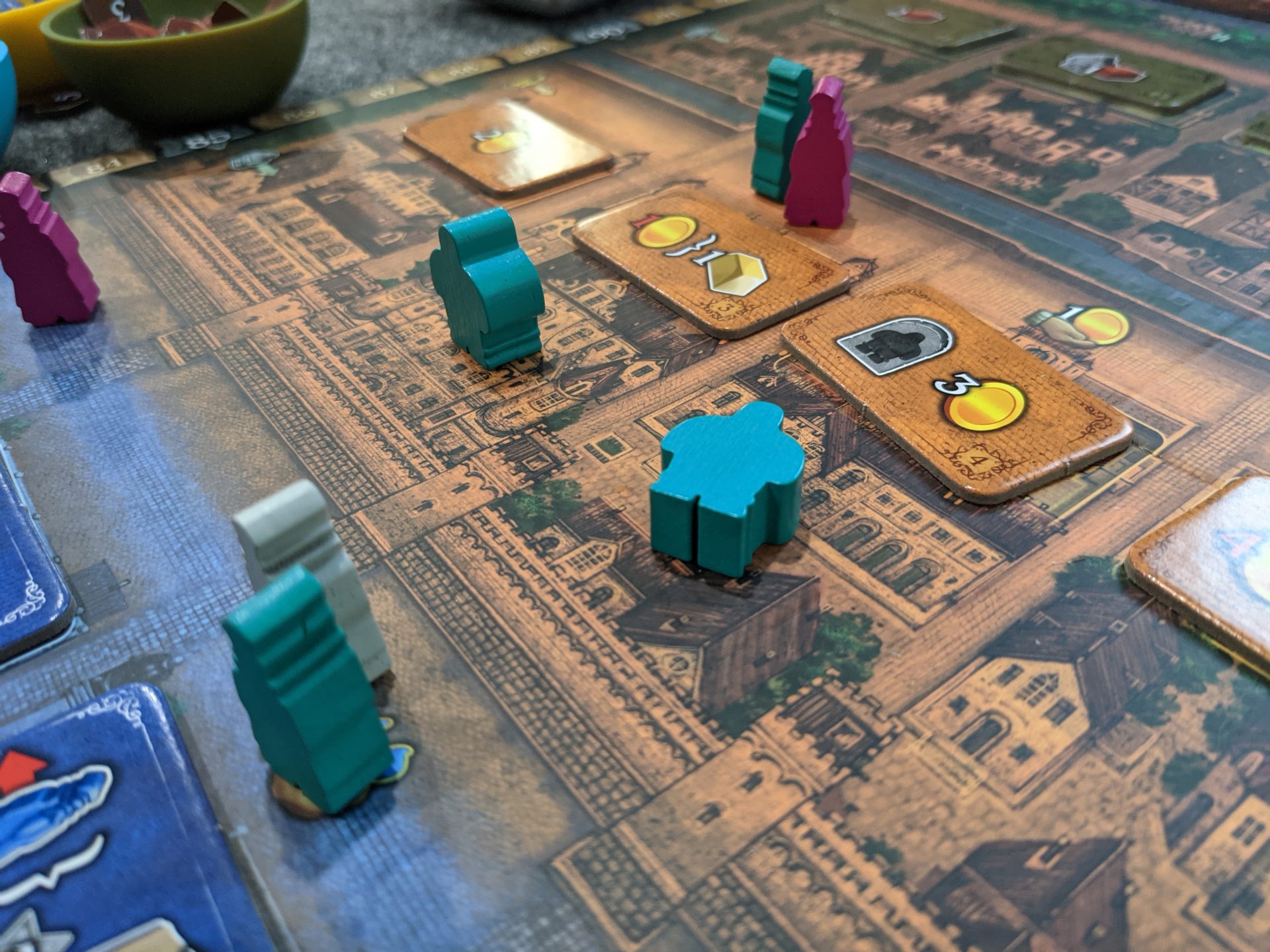A few friends of mine in Chicago recently came back from Essen Spiel, the granddaddy of them all when it comes to gaming conventions, and their haul included 30 of the hottest games in the world. They hosted a day of gaming at their home and had all of the goods on display.
“So, we have seats at Gutenberg, Golem, Bitoku, and Iberian Gauge. Which one do you want to play?”
“Golem,” I said without hesitation. Golem is designed by Virginio Gigli, Flaminia Brasini, and Simone Luciani. At least one of these 3 Italian luminaries had a hand in the design of all the following games: Grand Austria Hotel, Lorenzo il Magnifico, Alma Mater, Barrage, Coimbra, The Voyages of Marco Polo, and T’zolkin: The Mayan Calendar.
Yeah.
Lorenzo il Magnifico and Coimbra are two of my favorite games ever, so it was a no-brainer to take a stab at Golem. I left the table pretty impressed…but, this IS a “First Take” of Golem, so while I won’t give you a full breakdown of the rules here, I will tell you what I liked and what I didn’t in this hot take of the experience.

Systems Upon Systems
Golem is a full tier heavier than mid-weight Euros like Grand Austria Hotel and Lorenzo il Magnifico (both in the 3.2-3.3 range, per BGG’s weight rating), and this shows the second you try to set up the game. “Now THIS is a ‘modular’ setup,” one player commented as our guide set up Golem; the setup is somewhat ridiculous, in terms of how many different things need to be coordinated based on the experience level of the players, the number of players, and the tiles to be used in any given game.
So, what is Golem? At its heart, the game is a heavyweight engine builder built around the legend of a rabbi who reanimates a clay statue into a golem to protect the people of Prague in the 16th century. While the backstory—and its strangely dark box art—didn’t draw me in, the promise of building synergies between a variety of different economies did.
There are tracks. There are end-game goals. There are multipliers used to boost scoring, and while there is in-game scoring, more than half of my score came at the end. There are Student pieces to move. There are Golem pieces to move. There’s a Rabbi piece to move, for crying out loud! And that’s before you begin adding tiles, a separate artifact player board, along with your main player board, marbles, a synagogue to hold said marbles…there’s so much. (The manual has EIGHTEEN separate steps to set up the game.)
Now, if you are a fan of Vital Lacerda games such as On Mars and Lisboa, you are probably thinking what I was thinking as I sat through the 45-minute teach and the 20-page instruction manual: is this game just as heavy as a Lacerda?
The answer is a solid yes. That also means that if you love heavy games with systems upon systems, I think you are going to be right at home playing Golem. 4 rounds and only 12 total actions gave me the feeling this would be heavy and highly strategic but short; as it turned out, my 3-player game took about 3 hours after the teach and featured a nice mix of strategic gameplay and being forced to pivot based on the marble distribution in each round.

What I Liked: Almost Everything
The combos in this game, the big moments where you chain a solid move into another great play, are awesome. I mean, fantastic. I had a turn where I took an action to activate a couple of my Golems on a single turn. The way I made this move work out: do a Golem action to buy a book at a 5-Knowledge discount (Knowledge is one of the resources in the game), which slots into one of the columns on my player board with 3 other books already there, to give me a one-time bonus that gets doubled because I’ve already activated another power…just describing it all and rethinking how I pulled off this move is exhilarating.
All 3 players had at least a couple of those moves in the third and fourth round of the game; Golem does a great job of starting slow but opening up the potential for sick turns late, which will earn nods (or scowls) from other players around the table. Golem definitely has magic moments that make the experience stand out, with an engine-builder feel that ends just a tad too early…in other words, at just the right time!
I also loved the way turn order works. Like in most games, going first, is a good thing in Golem, particularly if you are looking to take that single black marble to move 2 students one space each on any of the 3 tracks, or if you are looking to take a specific Rabbi action. I also love going last in Golem, particularly because you may be faced with a situation where other players have taken both of their marble actions. Now on your second of three actions in a round, you are faced with taking a marble or a Rabbi action, and you could block a Rabbi action and wait to do the marble action since that area is blocked off for anyone who has taken 2 marbles already.
I appreciated that playing Grand Austria Hotel—and understanding how the “power” of an action is tied to the number of marbles left in any given row—helped me plan turns.
The card market, which is the book market in Golem, was fun and timing when to buy the right cards was great. Then putting those cards in certain columns to activate everything in a column can yield a resource bonanza, which can take the place of a good income engine if played right.
The production quality is great, although I wish the design team went with wooden brick components or fancier coins instead of the cardboard used in the final design.
Golem has lots of ways to win, and seems to point players towards specializing in one or two of the three main tracks in the game (Study, Artifacts, Golems). You have a lot to manage but while this is a heavier experience, it never feels completely overwhelming once you start playing.

What I Didn’t Like
For whatever reason, marbles just don’t work for me. Dice? Love dice, and I’m still not sure why dice were not used here like they were in other games from these designers.
The iconography in Golem is tough. Like Alma Mater, you are going to have to keep the manual handy to explain new round cards or what all of the bonuses are on the completed Golem body parts. By my third or fourth game, no problem, but it isn’t as intuitive as other similar games.
The theme? I still really have no idea why a themeless Euro would go for setting a game in 16th-century Prague with Golems—Golems which may be best off dead, thanks to a “Kill a Golem” mechanic!! And the idea that the marbles are the eyeballs that go into slots on a player board…I don’t know, the theme just didn’t work for me.
The yellow track has yellow spaces. The blue track has blue spaces. And the red track has…green spaces??? (No one at the table had an answer for that one.)
The tiebreaker. It didn’t come down to this, but whoever places their Rabbi in the highest space during the final round wins the game. This literally doesn’t matter in the final round; you will prioritize taking the space that benefits you the most, not the highest one in turn order. You are not fighting for turn order in the last round of ANY GAME!! Given that the tiebreaker for Alma Mater is also nonsensical, maybe this design team is so good at making games that they outsource tiebreaker development to other companies?
The Bottom Line
Despite some of those nitpicks, Golem is solid. If you are looking for a heavier version of some of the classics these designers have given us, Golem—which, like Barrage, is right around a 4.0 out of 5.0 in terms of weight on BGG—checks every box. I’m looking forward to future plays!












While I appreciate the review and agree with most points (the nitpick that people often fight for turn order in the last round of Tekhenu not withstanding), I cannot possibly imagine how anyone, at all, EVER could even begin to claim that Golem is as heavy as a Lacerda. Not to be too harsh, but I find that claim flatly absurd. Granted game weight is a bit subjective, but if I were rating Golem’s weight I’d likely put it under 3.5, probably somewhere around the same as Lorenzo or Grand Austria Hotel. While I was reading the rules and doing my first playthrough I kept thinking how nice of a change it was to being play a game that was a bit lighter (my friends often get tired of my constant need to play incredibly weighty games).
Editor here: Do you think you can agree that weight is a largely subjective metric? There are people would say that Ticket to Ride, or Catan, is “too heavy”. And let’s be clear that calling someone’s opinion “flatly absurd” isn’t welcome here. Make any rebuttals you like as long as you’re considerate.
My appologies if someone took offense. I thought my post WAS considerate. I didn’t use any harsh language and tried to acknowledge the author’s opinion while disagreeing in the strongest way possible (and acknowledging that what I was writing was my subjective opinion). I just think if I bought Golem after reading this review and was expecting a Lacerda depth game, I would be SORELY disappointed. I was only trying to create a counterpoint to the author’s opinion.
There’s nothing wrong with disagreeing, we’re more than happy with the discussion and I’m glad you took the time to comment. But saying someone’s opinion is “flatly absurd” isn’t discussion, its dismissive.
That said which parts of Golem did you specifically find lighter than expected? Alternately what about a Lacerda game do you find challenging and engaging?
Yes of course it’s not as heavy as Lacerda, but certainly much heavier than Lorenzo, Newton or Marco Polo…
An example: the passing action is really subtle to get right. I’ve read forums where they obviously did this action incorrectly and simpler than it actually is. A family audience + who plays Takenoko, Colt Express or Catan will be able to read (with a little effort) Lorenzo’s manual, but will give up in front of Golem, which fully assumes being a niche game. Then it is true that once you understand the system, there is a beautiful logical fluidity which rewards your efforts at understanding!
Thanks for the review – just to provide a counterpoint to you not liking marbles, if you knew the theme/movies well- it has always been about activating the golems with a marble inserted into their head. So they stuck to theme so well and even used marbles like in the legends – hats off for that! But I know the synagogue is clumsy etc and the turn order tie breaker surely is strange 🙂